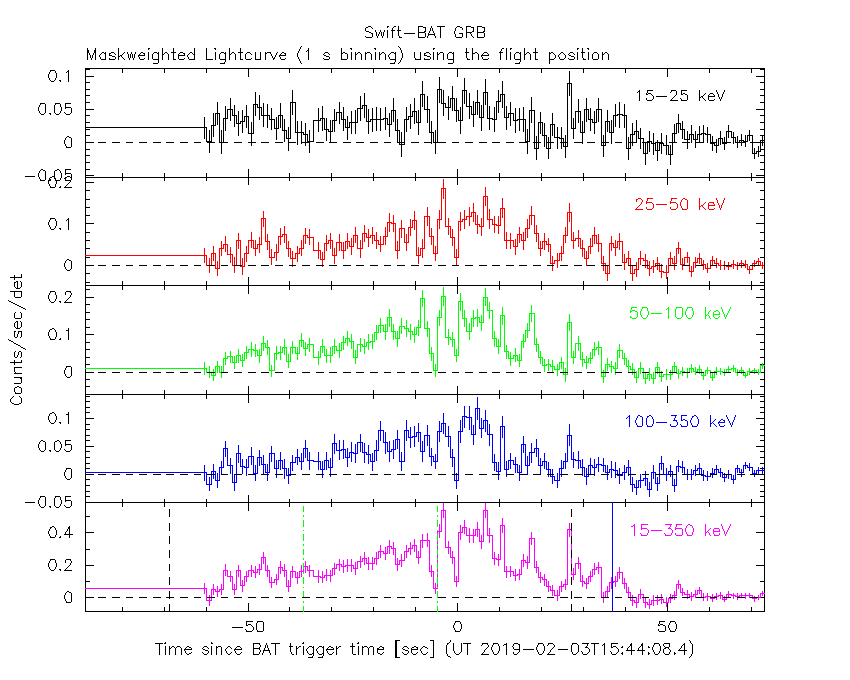
A.Y. Lien (GSFC/UMBC), A.P. Beardmore (U. Leicester) and P. Kuin (UCL/MSSL) for the Swift team
At 15:44:08 UT, the Swift Burst Alert Telescope (BAT) triggered and located GRB 190203A (trigger=887512) (Lien et al. GCN Circ. 23845). Swift slewed immediately to the burst. At the time of the trigger, the initial BAT position was 91° from the Sun (4.4 hours East) and 101° from the 1%-illuminated Moon. Table 1 contains the best reported positions from Swift, and the latest XRT position can be viewed at http://www.swift.ac.uk/xrt_positions.
Lien et al. (GCN Circ. 23845) reported the discovery with UVOT of an optical afterglow. Table 2 is a summary of GCN Circulars about this GRB from observatories other than Swift.
Standard analysis products for this burst are available at https://gcn.gsfc.nasa.gov/swift_gnd_ana.html.
As reported by Palmer et al. (GCN Circ. 23873),
the BAT ground-calculated position is RA, Dec = 22.603, 55.736 deg which is RA(J2000) = 0
The mask-weighted light curve (Figure 1) shows several overlapping pulses that starts ~ T-60 s and ends at T+40 s.
Note that there is a large data gap from T-117.652 s to T-60.784 s, so it is possible that there is additional burst emission during this interval.
The time-averaged spectrum from T-60.784 to T+ 43.216 s is best fit by a simple power-law model.
The power law index of the time-averaged spectrum is 1.06 ± 0.06.
The fluence in the 15-150 keV band is 1.5 ± 0.05 x 1
The results of the batgrbproduct analysis are available at https://gcn.gsfc.nasa.gov/notices_s/887512/BA/.
Analysis of the initial XRT data was reported by Beardmore et al. (GCN Circ. 23858). We have analysed 19 ks of XRT data for GRB 190203A, from 103 s to 228.9 ks after the BAT trigger. The data comprise 669 s in Windowed Timing (WT) mode (the first 8 s were taken while Swift was slewing) with the remainder in Photon Counting (PC) mode. The enhanced XRT position for this burst was given by Goad et al. (GCN Circ. 23848).
The late-time light curve (Figure 2) (from T0+4.1 ks) can be modelled with a power-law decay with a decay index of α=1.76 ± 0.06.
A spectrum formed from the WT mode data can be fitted with an absorbed power-law with a photon spectral index of 1.69 ± 0.04. The best-fitting absorption column is 7.2 ± 0.5 x 1
A summary of the PC-mode spectrum is thus:
Total column: 7.0 (+2.0, -1.7) x 1
Galactic foreground: 4.0 x 1
Excess significance: 3.0 σ
Photon index: 1.63 (+0.21, -0.20)
The results of the XRT team automatic analysis are available at http://www.swift.ac.uk/xrt_products/00887512.
The Swift/UVOT began settled observations of the field of GRB 190203A 121 s after the BAT trigger
(Kuin and Lien GCN Circ. 23865).
A source consistent with the XRT position (Goad et al. GCN Circ. 23848) is detected in the initial UVOT exposures.
Table 3 gives preliminary
magnitudes using the UVOT photometric system
(Breeveld et al. 2011, AIP Conf. Proc., 1358, 373).
No correction has been made for the expected extinction in the Milky Way
corresponding to a reddening of

Figure 1. The BAT
mask-weighted light curve in the four individual and total
energy bands. The units are counts

Figure 2. The XRT light curve.
Any data from a crosshatched region are not included in the fit.
| RA (J2000) | Dec (J2000) | Error | Note | Reference |
|---|---|---|---|---|
| 0 |
+55°43'20.6" | 0.46" | UVOT-refined | Kuin and Lien GCN Circ. 23865 |
| 0 |
+55°43'20.4" | 1.4" | XRT-final | UKSSDC |
| 0 |
+55°43'19.9" | 2.7" | XRT-enhanced | Goad et al. GCN Circ. 23848 |
| 0 |
+55°44'10.5" | 1.0' | BAT-refined | Palmer et al. GCN Circ. 23873 |
| Band | Authors | GCN Circ. | Subject | Observatory | Notes |
|---|---|---|---|---|---|
| Optical | Novichonok et al. | 23846 | Koshka Zeiss-1000 optical upper limit | Zeiss-1000 | upper limits |
| Optical | Moskvitin et al. | 23847 | SAO RAS optical observations, afterglow fading |
SAO RAS | detection |
| Optical | Lipunov et al. | 23850 | MASTER OT detection | MASTER | detection |
| Optical | Izzo et al. | 23860 | Liverpool Telescope near-IR observations | Liverpool Telescope | |
| Optical | Watson et al. | 23864 | COATLI Optical Observations | COATLI | |
| Optical | Volnova et al. | 23878 | Mondy optical observations | Mondy | detection |
| Gamma-ray | Frederiks et al. | 23859 | Konus-Wind observation | Konus-Wind | |
| Gamma-ray | Khanam et al. | 23866 | AstroSat CZTI detection | CZTI |
| Filter | Exp(s) | Mag | ||
|---|---|---|---|---|
| white | 121 | 271 | 147 | 18.66 ± 0.06 |
| v | 609 | 5462 | 225 | >19.2 |
| b | 535 | 4846 | 236 | >20.5 |
| u | 279 | 5967 | 551 | >21.0 |
| w1 | 658 | 5872 | 413 | >20.2 |
| m2 | 634 | 5666 | 413 | >21.0 |
| w2 | 585 | 5257 | 236 | >20.2 |
Table 3. UVOT observations reported by Kuin and Lien (GCN Circ. 23865). The start and stop times of the exposures are given in seconds since the BAT trigger. The preliminary detections and 3-σ upper limits are given. No correction has been made for extinction in the Milky Way.
February 7, 2019